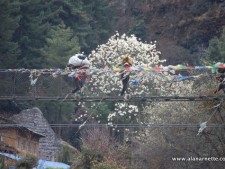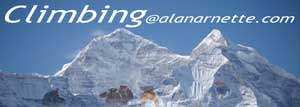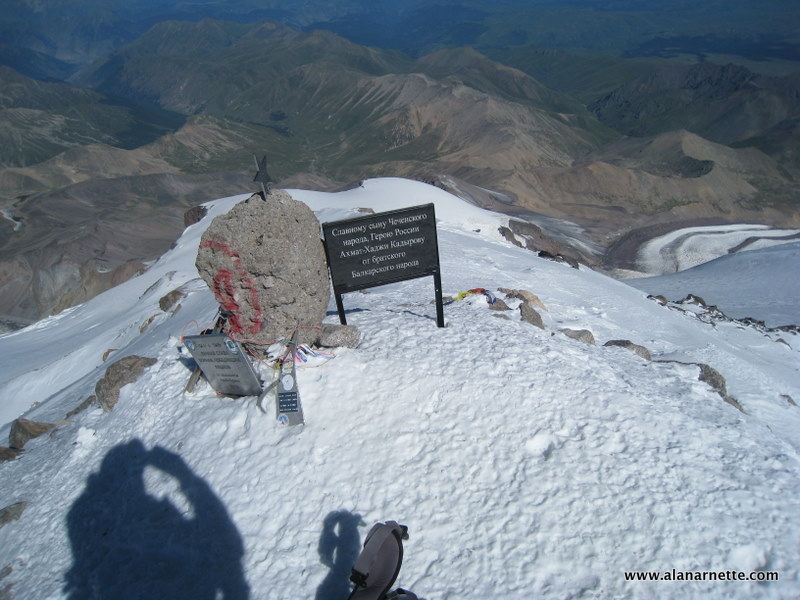
The phone rang at 4:00 AM sharp, our wakeup call to get to the Kathmandu airport and our flight to Lukla. I was conscious of how I felt as I changed from traveling clothes to trekking clothes – excited, anticipatory, perhaps a bit anxious of the task ahead. But the overwhelming feeling was a sense of deep reflection on the opportunity and the cause.
Our team of climbers, trekkers, guides and a few of our Sherpas loaded onto a bus for the quick ride to the airport. It was perhaps the only time to see a quiet Kathmandu. The streets were empty sans a runner or two avoiding the oppressive air of the day. Once at the airport the duffel shuffle began with everyone helping out as we moved our trekking duffles from the bus through security to the scales and finally onto a dolly for loading on the Twin Otter.
The Kathmandu airport staff was relaxed and friendly. They see thousands of us each year go through the process of asking if you have a knife or a lighter in your bag, patting you down, checking our packs – the routine. But it is with a smile and a casual attitude; this is Nepal.
We loaded on the plane with an increased sense of excitement. The Twin Otter is a small twin prop plane used around the world to transport people and gear in remote and difficult areas. My last ride on one was in Antarctica only a few months ago. Maybe 15 rows of one seat on the left and two on the right, the plane was filled. The flight attendant passed out cotton to plug our ears and a small piece of candy.
The sun was hidden by the morning haze as the props spun to speed and we lifted off the runway. The flight was only 35 minutes but the views will last a lifetime. I felt another wave come over me as the nose tipped down slightly and in a moment we made a smooth landing onto the tiny airstrip. The trek was officially on.
After a quick visit to the Lukla bakery for strudel and coffee, our team split from our bags. An eager group of porters took one, two, even three of our 60lb bags. Carefully strapped to their backs with a head strap providing most of the support, they left Lukla to meet us at Phakding a few hours later. I think my duffle was lager than my porter. I watched with a mix of admiration and embarrassment.
The trek to Phakdang is downhill, a rarity on this expedition. The trails are dirt, the surroundings; fir and pine trees and snow covered mountains provide the curtains. A mix of white and grey clouds allowed a filtered sun to warm the day. However, honestly, we were all warm with smiles as we set a swift pace on this Khumbu road.
A few hours later we arrived at our teahouse, enjoyed an afternoon tea and a welcome dinner before going to bed around 8. This is the new norm.
Up at 6:00AM, we had a relaxed breakfast and then left for what some consider one of the more difficult days of a Khumbu trek: the infamous Namche Hill.
 The section to Namche is my absolute favorite. My senses are quickly overloaded. The rhododendrons and cherry trees were in full bloom providing a bight red and white contrast to the green fields. Women tended the fields, planting potatoes, barley, cabbage and other food to meet their own needs plus to service the teahouses. Local commerce at it’s .
The section to Namche is my absolute favorite. My senses are quickly overloaded. The rhododendrons and cherry trees were in full bloom providing a bight red and white contrast to the green fields. Women tended the fields, planting potatoes, barley, cabbage and other food to meet their own needs plus to service the teahouses. Local commerce at it’s .
The dirt trail was dry, albeit rocky, as it meandered high above the Dodi Khose river; it’s rushing water providing a natural audio accompaniment to the sights. The villages are spaced close together; each individual but all filled with small children playing on the dirt trails with small balls, used water bottles or simple sticks. The common theme was big smiles and loud laughs. Usually a mother or grandmother washed clothes nearby or tended a field but you knew one eye was always on their most prized possessions.
Many of the older kids were in school so the trails were quieter than normal. Also, I felt there are fewer people here in general. Even the teahouses feel less crowded.
 We made our way along the trail and soon stopped for an early lunch just outside the Sagamatha National park entrance. Our expedition leader, Greg, handled the permit formalities and soon the group joined him as we continued our trek towards Namche. Again the colors and sounds filled our senses along with the smell of fresh tilled dirt.
We made our way along the trail and soon stopped for an early lunch just outside the Sagamatha National park entrance. Our expedition leader, Greg, handled the permit formalities and soon the group joined him as we continued our trek towards Namche. Again the colors and sounds filled our senses along with the smell of fresh tilled dirt.
The trail dropped down to the rushing river but gained altitude to meet steel cabled bridges providing easy access as we traversed the rapids multiple times. Sharing the bridge with Zo’s (a cross between a yak and a cow), loaded with our gear; porters, loaded with our gear; we knew our place and stepped aside when needed. Finally we crossed one last high bridge to the base of the Namche Hill.
The hill is about 2000′ gain to the capital and largest village in the Khumbu. It is the only way to get there by foot so we shared it with other visitors plus the locals. A small Zo train lead the way setting a pace only exceed by a rock rolling up hill. We settled in place and accepted a traffic jam in the middle of the Khumbu.
One by one, we passed the beasts as the trail widened. We steadily gained altitude as the heat of the day broke through the clouds. Each break was welcome. But with determination, our team worked the trail and the buildings of Namche revealed themselves six hours after breakfast.
Pale white stone buildings with white, red and green sheet metal roofs lined the natural amphitheater. The streets are dirt and lined with shops selling trinkets but also food, climbing supplies and hot baked goods. There is a , a dentist, a pool hall and an internet cafe. Satellite communication keeps this remote village in touch with the rest of the world. Hydroelectric plants power the Khumbu.
I am writing this sitting in the dining room of our Teahouse, the Khumbu Lodge. The varnished wooden table and blanket covered benches provide a very comfortable setting. The quiet mummer of fellow climbers and trekkers fill the room.
Sights and sounds of the trek to Namche. Truly: Memories are Everything.
Climb On!
Alan




12 thoughts on “Sights and Sounds of the Khumbu”
I wish I were there!! I love Namche – best chicken and frys at the Hotel Base Camp. Think about that on your way down from the top of the world. Best of luck Alan – I will be following your expedition daily. I have my world famous lucky buddha eyes out so you will have a perfect summit window. Very Best – Matt
Go Alan , , Ah Yes that Last Bridge , i think it stays with you forever and ever !! Great work Alan .Regards to the Khumbu Lodge from the AC 08 Island Peak Team. Nick
Leaving in 20 days to join everyone there on an EBC trek and Island Peak climb …. It will be my first time in Nepal and the Khumbu; your posts are fuelling my excitement and motivating my last weeks of training! Thank you so much Alan and see you in base camp if you aren’t on a rotation !! Good luck… Namaste…
Your description is so vivid…looking forward to visit the Khumbu in november when I do my gokyo lakes trek
It feels like I’m there. I wish I was.
Just wanted to let you know that you have some followers in Western Canada that are very much enjoying you sharing this adventure that you are on. Climb on !!
Alan….so descriptive I can almost feel like I am there….thank you so much for sharing your wonderful experiences
Wow! thats about all I can say. It sounds like a difficult trek. I know this is probably nothing compared to whats ahead.
Thank you so much for sharing this experience!!!
As Maurichio said… your description takes me back also. I remember that last long high bridge and some time later seeing the buildings of Namche thru the trees and thinking …Finally !….Keep “taking” us with you on that trail to BC… then Climb On !
Climb on!
Oh, gosh. I am soooo envious! Your vivid descriptions almost make me smell the smells that you are smelling. They refresh my memories of my own trek to Base Camp in ’03. Thanks for sharing this experience, Alan. I look forward to it every day!
That’s great Alan. Your description takes me back almost one year ago. I stayed in the Krylev Lodge in Namche way above you guys. So after getting through Namche Hill, we had to hike up some more.
Comments are closed.